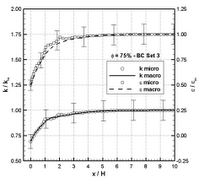MotivationThe analysis of fluid flowing through porous media is required in a large range of applications in such industries as chemical, mechanical, nuclear, geological, environmental, petroleum, etc. The pore-size’s spectrum is vast and the conditions encountered in different applications are broad enough to cover a large range of Reynolds numbers. Turbulent flows in porous media are characterized by a large range of spatial scales. In such flows, spatial scales that range from the dissipation range inside each pore to the large scale defined by the entire porous medium need to be resolved. Therefore, the computational effort required to solve the flow field in such geometries is still out of reach. This motivates the research in the development of porous media approximations (i.e. models), representing the system composed of pores by a macroscopic homogeneous one with uniform properties. Goals: Models for turbulence in porous mediaDevelop new models to describe turbulent flows in porous media (Note that there is no agreement in the research community as to which approach to model turbulence effects in porous media is most suitable). The creative process is constrained to the following points: - Comparison and study of existing models;
- Developing equations that conserve quantities of the flow such as the kinetic energy;
- Developing of numerical experiment to validate the models.
AchievementsA new model has been developed that posses the following features: - It models the entire kinetic energy filtered in the averaging process;
- It does not neglect any terms in the development; and
- All terms in the final form of the k and ε equations, in addition to the terms similar to those that appear in the corresponding equations for clear flow, result from the interaction between the solid and fluid phases.
Publications Teruel, F. E. and Rizwann-uddin. Dependence of the macroscopic turbulence quantities on the Reynolds number and porosity. In preparation.
Teruel, F. E. and Rizwann-uddin. Characterization of a porous medium employing numerical tools: permeability and pressure-drop from Darcy to turbulence. Under revision in theInternational Journal of Heat and Mass Transfer.
Teruel, F. E. and Rizwann-uddin. A new turbulence model for porous media flows. Part II: Analysis and validation using microscopic simulations. International Journal of Heat and Mass Transfer. 2009. In Press (PDF).
Teruel, F. E. and Rizwann-uddin. A new turbulence model for porous media flows. Part I: Constitutive equations and model closure. International Journal of Heat and Mass Transfer. 2009. In Press (PDF).
Teruel, F. E. and Rizwann-uddin. Macroscopic modeling of turbulence in porous media flows. Proc. of ENIEF 2008, 2008. On CD-ROM (pag. 265-280).
Teruel, F. E. and Rizwann-uddin. Alternative modeling for turbulent flow in porous media. Proc. of 2nd joint U.S.-European Fluid Engineering Summer Meeting, 2006. On CD-ROM. | Model validation Microscopic (i.e. real geometry) numerical simulations have been compared with model results. This has been useful to determinate models constants and to compare the capability of the model to represent the behavior of the flow.
Top: Distribution of the microscopic Turbulent Kinetic Energy obtained from microscopic simulations (Re = 104, Porosity = 75%).

Bottom: streamlines of the flow in the developing region and in the macroscopic fully developed region.

Comparison for the streamwise evolution of the Macroscopic Turbulent Kinetic Energy and the Macroscopic Dissipation Rate calculated using the microscopic simulation, and the macroscopic model, for two different boundary conditions.
Movies Watch movies of oscillatory flow in the Representative Elementary Volumes of the porous medium: 55% porosity – Re = 180. 75% porosity – Re = 150. 95% porosity – Re = 150. 95% porosity – Re = 1000 (RANS).
Contact info: teruel@cab.cnea.gov.ar, rizwan@illinois.edu |